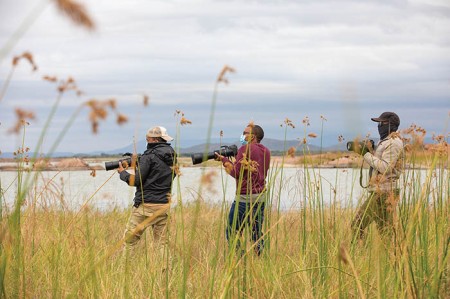Following the 'Bird Boys' of Gaborone
Thalefang Charles | Friday May 14, 2021 16:35


That is how I met Mabedi Letsholo of Mabedilets Photography, Brians Moneke of Brains Bond Nature Photography and Oteng Lekgowe of Oteng Lekgowe Photography. They are all Gaborone-based nature photographers who are juggling their ‘nine-to-five’ jobs with capturing beautiful images around the city.
Letsholo is a civil servant at the former president’s office as private secretary to Ian Khama. Letsholo, 34, is shooting on a Canon 90D with a Canon 100-400mm USM lens. He is the master of the bokeh. He loves the shallow depth of field. His photography is characterised by sharp subjects framed by pleasing blurred backgrounds. And it works perfectly with small colourful birds.
Then there is the banker, Lekgowe. Born 37 years ago and raised in Gaborone, his day job is at FNBB. During weekends he ‘clears his mind’ photographing nature around Gaborone with his Canon 90D and 15-600mm Sigma lens. Lekgowe’s love for photography came at a young age.
“My old bother gave me a camera and I used to go ko morakeng and shoot things like beetles,” he recalls. The passion grew in him and he bought a decent camera to push his passion. Right now he knows all the best spots around Gaborone for bird photography. He usually visits Gaborone Dam or the Game Reserve. Lekgowe credits local nature photographers like Joe Misika and Karabo Moilwa of the Chobe Collective as mentors who nurtured his love for nature photography.
Forensic scientist, Brains Moneke with his Canon 7D and 150-500mm Sigma Lens completes the trio. Moneke, 34, is the nerd who self-taught the art of photography ‘in reverse’.
“I started learning post-production first. I learnt about layers before I even shot pictures,” he explained.
He picked up his first DSLR camera from his sister’s school project, a Canon 1000D in 2009. But it was 10 years later that he actually got to use it. His story is a familiar photographer’s story of one that was inspired by travel. Coming from a picturesque part of Botswana at Mathathane near the Tuli Block, he did game drives in the Tuli area and that nurtured his passion for nature. Facebook played a vital role in his photography because it was after he started posting images on social media that people’s appreciation inspired him more.
Moneke then began searching for stuff to photograph and in the absence of big game, he developed a love and obsession for birds. “I didn’t even know any bird back then, so I researched a lot,” he said. Moneke disclosed that he uses the Merlin bird application to learn more about birds. He made it a routine to visit Gaborone Dam every Saturday morning to look for birds.
As I met all the three lensmen together last week Sunday at the cold Gaborone Dam, they were all worried about the overcast conditions, not the cold.
“The light is not too good,” they kept looking up the sky.
We then embarked on the hike through the tall soaked papyrus reeds and the Great Cormorants flew past. This was the first wetland birds surprise and many more to come. There was a pair of Pied Kingfishers hovering over the water and the guys aimed their long lenses and the shutter cried from their bulky cameras. Then there were the Black-Headed Herons sitting pretty on the dam rocks. The Blacksmith Lapwing did not get appreciation from the photographers who said their metallic ‘tink-tink-tink’ calls are alarm sounds for other birds to fly away.
After every shoot, the boys show one another whether they caught any nice shots and share advice. It is a beautiful camaraderie that helps them keep perfect their shots. Hours into the shot and after a long walk, a Malachite Kingfisher is spotted. It is a pretty colourful bird that is Moneke’s favourite and he has never seen it at the dam. Few laboured shots later, the little bird flies away about 400m from where it was spotted and the guys agree to go back and try their luck on the bird. They have all learnt that patience is a necessary skill with birds.
At the end of five hours of stalking, as the winter sun suddenly heated up, we spotted Little Bee-Eaters next to the road. Moneke said it was their usual spot. This was where he spent hours photographing them over the months.
“This is where I got to understand their behaviour,” he said.
Although they still call themselves ‘hobbyists’, these photographers take their hobby very seriously. And that is why they hope to sell some of their finest images.
